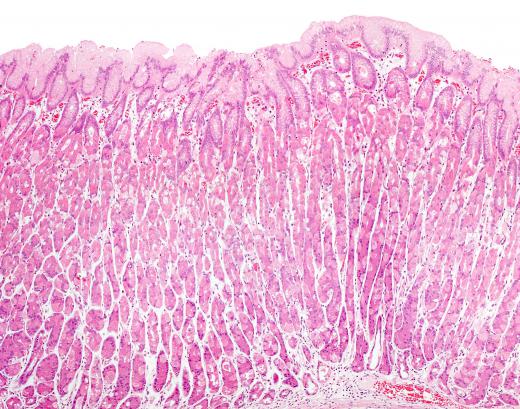What is Selective Permeability?
In cell biology, selective permeability is the property of a living cell membrane that allows the cell to control which molecules can pass through the membrane, moving into or out of the cell. In order to understand this property, it helps to be aware that there are three different methods by which molecules can move into or out of cells: passive transport, active transport, and transport by the use of vesicles.
In passive transport across a selectively permeable membrane, molecules move across the membrane without the cell having to expend any extra energy. When water molecules move passively into or out of a cell, for example, this is called osmosis. Other small molecules may move across the membrane by the process of diffusion. This means that they move across the cell membrane from an area of high concentration to an area of low concentration. Oxygen molecules may diffuse from the lung cavity by passive transport into blood cells in the lung.

Active transport is a vital mechanism used by living cells for selective permeability. This method is necessary for small molecules to move across the cell membrane in situations where the molecules need to move against a concentration gradient. Unlike passive transport, active transport gives the cell the ability to move molecules from an area of low concentration to an area of high concentration. This works by means of special channels called pumps, which are present in the cell plasma membrane, and that use up energy when they move molecules across the membrane. Active transport is often used by cells lining the stomach to absorb glucose, amino acids, and other nutrients.

Vesicles are tiny pockets that may form in the cell membrane to aid in the transport of larger molecules. The vesicles allow the cell to take in or eject these molecules across the cell membrane. This process is called endocytosis when molecules are moved into the cell and exocytosis when molecules are moved out of the cell.
Selective permeability of membranes generally depends on the size of the molecules, the positive or negative charge of the molecules, and their solubility in water or oil. In plasma cell membranes, it also depends on many biological functions and biochemical reactions both within and outside each cell. It is one of a living cell's most vital biochemical attributes, and it is a fundamental part of most of the vital processes needed to support life.
AS FEATURED ON:
AS FEATURED ON:
















Discussion Comments
@snickerish - I hope I can help!
The fluid mosaic model is a model that shows where the substances such as proteins and lipids within the cell membrane are arranged. The model has now been around for over 30 years.
So I think the fluid mosaic model has to do with selective permeability because they both have to do with the cell's membrane. Selective permeability describes the property of the cell membrane that allows the cell to control molecules moving in and out of the cell via the cell membrane and the fluid mosaic model shows you the arrangement of the substances of the cell membrane.
Okay, I think I understand what selective permeability is and how the cell's structures allow molecules to move in and out of a cell via the 3 different methods.
But my biology class keeps throwing around the words "fluid mosaic model" at the same time. I haven't quite figured out what it has to do with selective permeability, any ideas?
Post your comments